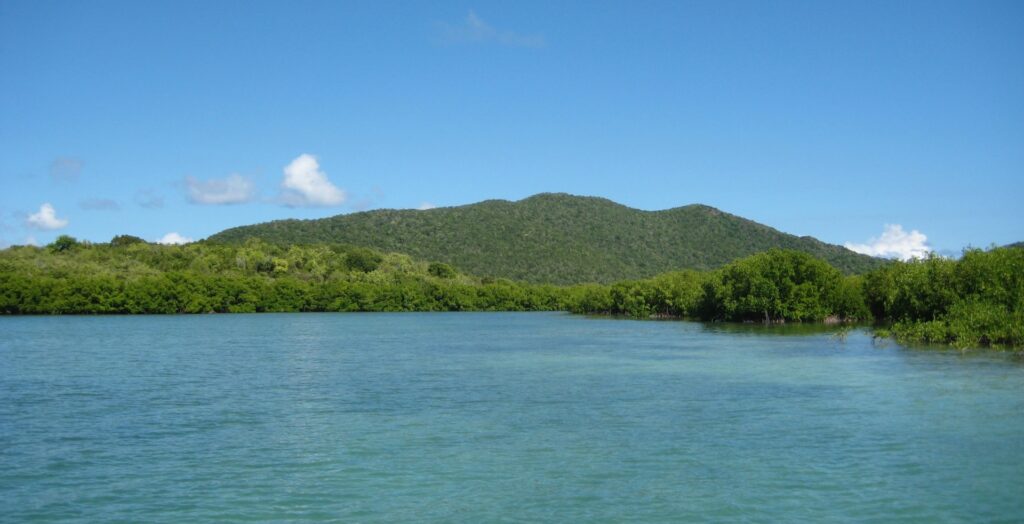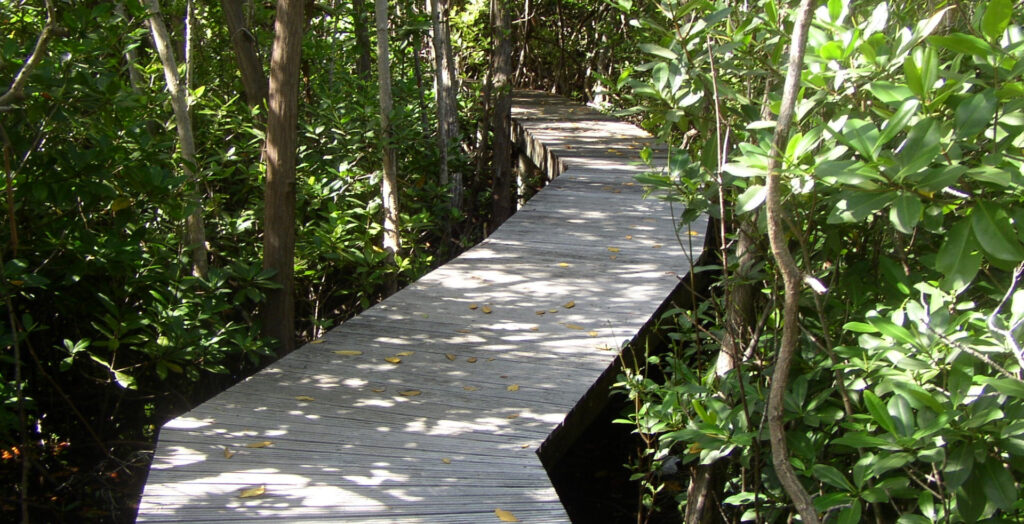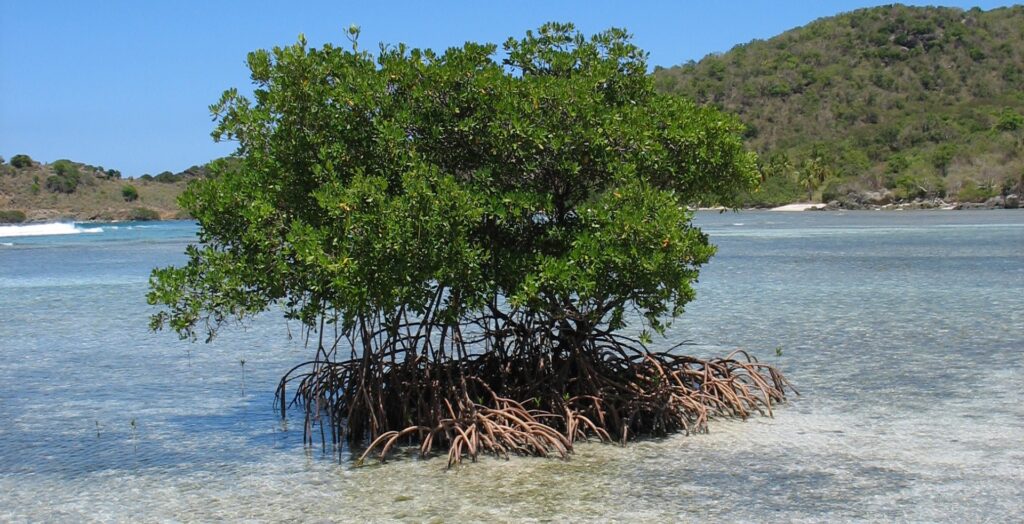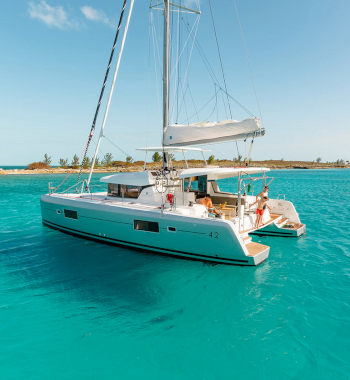The BVI’s Mangroves and their Awesome Super Powers
By Claudia Colli
I have a special affinity for mangroves, one of the BVI’s super plants. Growing along the islands’ shorelines, they serve the BVI in many unique and special ways. A marvel of nature, mangroves have profound consequences for the BVI’s marine and land environments.

I particularly enjoy observing mangroves from a kayak – totally in awe of these amazing trees that live in the brackish water on Tortola’s shorelines. Their sculptural roots bend downwards into the water, like giant ballerinas standing en pointe.
But kayaking is not the only way to appreciate these beautiful trees. From the land side, they are often a tangle of trunks, roots and leaves, which can make it difficult to penetrate their inner sanctum. But there are a couple of areas where they are accessible. One of the most pleasant is along a boardwalk built through a mangrove stand adjacent to the H.L. Stoutt Community College’s Marine Science Center. I’m not the only one who appreciates it. Along with local nature lovers, the area is a favorite stopping off spot for visiting dignitaries. King Charles’ sister, Princess Ann is among those who have strolled along this bucolic boardwalk.
Or, if you are on Anegada, walk along the dock at Fisherman’s Wharf. The dock is of historical and cultural significance to the islanders, so is worth a visit if you are on the island. Mangroves line both sides of this combination boardwalk and dock; colorful fishing skiffs are tied up within these sheltering trees.
Whether you reach them by sea or by land, these unique forests are one of the Virgin Islands’ greatest natural treasures.
Discover the BVI’s Mangroves
Among my favorites are the mangroves that fringe Manatee Point at Sea Cows Bay just west of Road Town. Another favorite area of mine is Hans Creek on Beef Island. The area is dense with mangroves and has a remote, almost primordial feeling. On a kayak, I can skirt along their outer rim and appreciate all that these trees have to offer, from their graceful beauty to acting as a shelter for marine life.

Mangroves are scattered throughout the Virgin Islands including Belmont Pond on Tortola’s West End, and Hodges Creek which is located east of Road Town. There is a small clump of mangroves at Road Reef, just west of Road Town. One of the densest stands on Tortola can be found at Paraquita Bay, which also provides a safe shelter for boats during storms. There are mangrove stands at Flamingo Pond on Anegada, as well as Deep Bay on Virgin Gorda. The east end of Jost Van Dyke has a mangrove stand as well.
Unfortunately, the picture is not all rosy for the BVI’s mangroves. Development has taken its toll and many important areas on the BVI’s shorelines have succumbed to landfill and construction. It is therefore important to appreciate their value to the environment as well as their unique super powers.
Four types of mangrove species are found here in the BVI: Red Mangrove (Rhizophora mangle); White Mangrove (Laguncularia racemose); Black Mangrove (Avicennia germinans) and Buttonwood Mangrove (Conocarpus erectus).
Mangroves are unique in their contribution to sheltering hundreds of marine species. They act as a nursery for small fish and other aquatic life. In addition to fish, conch, crabs, sea eggs and lobsters spend their formative years in red mangrove roots, which form shelters that are a vital part of protecting and nurturing the BVI’s fisheries.
In addition, mangroves protect shorelines from natural disasters, acting as a buffer from strong wave action that might otherwise pummel shorelines and erode beaches and topsoil. Conversely, they protect the sea and coral reefs from runoff during heavy rainfall from storms which might otherwise damage the coral. Another cool byproduct of this is that the silt, soil and sediments caught by the mangrove roots can eventually create additional land.

And impressively they are one of the planet’s most effective natural carbon capture systems which helps mitigate the effect of climate change in a big way.
The BVI’s Four Types of Mangroves
Red Mangrove
Red mangroves grow directly in salt water. Their tangle of unique prop roots is a great habitat for juvenile aquatic animals. In the BVI these trees can grow 50 feet tall. They have a unique way of reproducing. First, they create a propagule. This is a vegetative structure that can become detached from a plant and create a new plant. Though resembling an elongated seed pod, the fully grown propagule on the mangrove is capable of rooting and producing a new tree. The trees are capable of self-pollination and wind pollination. A mangrove propagule may float in brackish water for over a year before rooting.
White Mangrove
The White Mangrove tends to be located farther upland than either the red or black mangroves. It has no visible aerial root systems. Its leaves are rounded at the base and the tip, and are smooth underneath.
Black Mangrove
Possessing dark gray or black bark and leaves the Black Mangrove has traditionally been used by Virgin Islanders to fashion fence posts, fish pots and charcoal production. It normally produces pneumatophores, which provide a safe place for wading birds to hide their nests. Pneumatophores are respiratory or knee roots that project above the mud and have small openings (lenticels) through which air enters, passing through the soft spongy tissue to the roots beneath the mud.
The leaves are a deep green color on top and paler green below. The leaves are oval-shaped and grow opposite each other on twigs.
Buttonwood Mangroves
The Buttonwood Mangrove is an associate of the mangrove and is generally found in areas where mangroves are found. They grow further inland than the three true species of mangroves, and because of this, are excellent buffer systems for pollution, wind and storm surge.
For many mangroves, salt is dealt with after it enters the plant. Mangroves that are categorized as secretors including the Black Mangrove, push salt from the ocean water out through special pores or salt glands within their leaves.
The Nature Conservancy Sums It Up
The Nature Conservancy, one of the world’s premier environmental groups, sums it up perfectly: “Mangroves are home to hundreds of species, natural buffers against disasters and one of the world’s most effective natural carbon capture systems. One could be forgiven for thinking that mangroves have super powers.”
The next time I am paddling through mangroves in a kayak, or just admiring these beautiful trees lining the BVI’s shorelines, I will appreciate the role they play in protecting the Virgin Islands’ environment, its fishing industry, and the health of its marine life.






